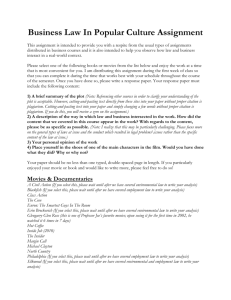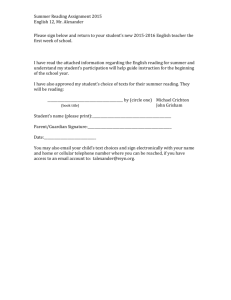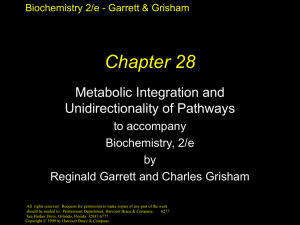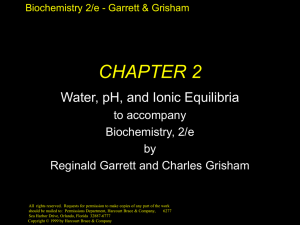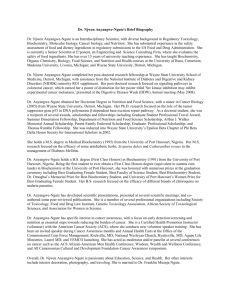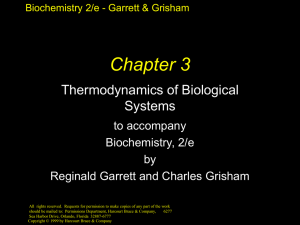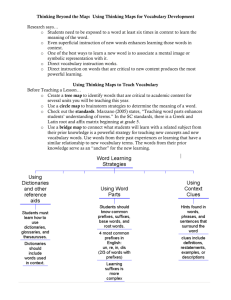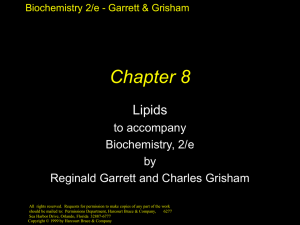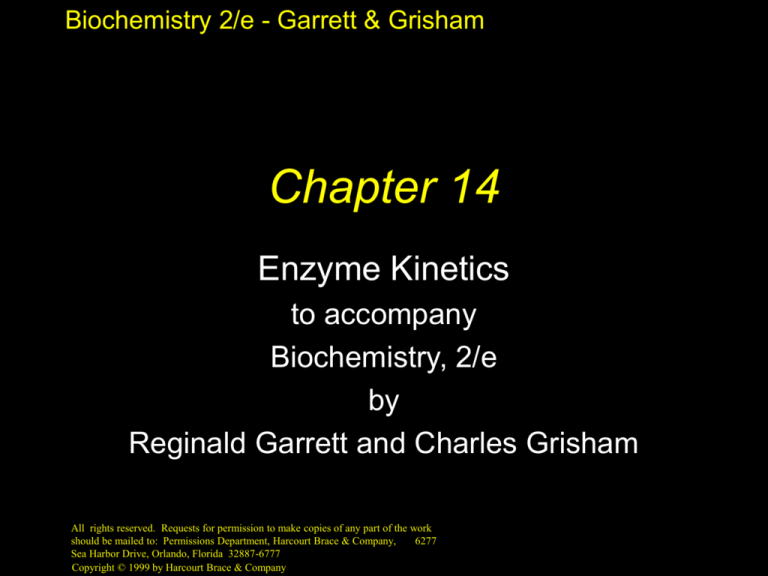
Biochemistry 2/e - Garrett & Grisham
Chapter 14
Enzyme Kinetics
to accompany
Biochemistry, 2/e
by
Reginald Garrett and Charles Grisham
All rights reserved. Requests for permission to make copies of any part of the work
should be mailed to: Permissions Department, Harcourt Brace & Company,
6277
Sea Harbor Drive, Orlando, Florida 32887-6777
Copyright © 1999 by Harcourt Brace & Company
Biochemistry 2/e - Garrett & Grisham
Outline
• 14.1 Catalytic Power, Specificity,
Regulation
• 14.2 Introduction to Enzyme Kinetics
• 14.3 Kinetics of Enzyme-Catalyzed
Reactions
• 14.4 Enzyme Inhibition
• 14.5 Kinetics of Two-Substrate Reactions
• 14.6 Ribozymes and Abzymes
Copyright © 1999 by Harcourt Brace & Company
Biochemistry 2/e - Garrett & Grisham
Enzymes
• Enzymes endow cells with the
remarkable capacity to exert kinetic
control over thermodynamic potentiality
• Enzymes are the agents of metabolic
function
Copyright © 1999 by Harcourt Brace & Company
Biochemistry 2/e - Garrett & Grisham
Copyright © 1999 by Harcourt Brace & Company
Biochemistry 2/e - Garrett & Grisham
Copyright © 1999 by Harcourt Brace & Company
Biochemistry 2/e - Garrett & Grisham
Copyright © 1999 by Harcourt Brace & Company
Biochemistry 2/e - Garrett & Grisham
Copyright © 1999 by Harcourt Brace & Company
Biochemistry 2/e - Garrett & Grisham
Catalytic Power
• Enzymes can accelerate reactions as
much as 1016 over uncatalyzed rates!
• Urease is a good example:
– Catalyzed rate: 3x104/sec
– Uncatalyzed rate: 3x10 -10/sec
– Ratio is 1x1014 !
Copyright © 1999 by Harcourt Brace & Company
Biochemistry 2/e - Garrett & Grisham
Specificity
• Enzymes selectively recognize proper
substrates over other molecules
• Enzymes produce products in very high
yields - often much greater than 95%
• Specificity is controlled by structure the unique fit of substrate with enzyme
controls the selectivity for substrate and
the product yield
Copyright © 1999 by Harcourt Brace & Company
Biochemistry 2/e - Garrett & Grisham
Other Aspects of Enzymes
• Regulation - to be covered in Chapter 15
• Mechanisms - to be covered in Chapter 16
• Coenzymes - to be covered in Chapter 18
Copyright © 1999 by Harcourt Brace & Company
Biochemistry 2/e - Garrett & Grisham
14.2 Enzyme Kinetics
•
•
•
•
•
Several terms to know!
rate or velocity
rate constant
rate law
order of a reaction
molecularity of a reaction
Copyright © 1999 by Harcourt Brace & Company
Biochemistry 2/e - Garrett & Grisham
Copyright © 1999 by Harcourt Brace & Company
Biochemistry 2/e - Garrett & Grisham
The Transition State
Understand the difference between G
and G‡
• The overall free energy change for a
reaction is related to the equilibrium
constant
• The free energy of activation for a reaction
is related to the rate constant
• It is extremely important to appreciate this
distinction!
Copyright © 1999 by Harcourt Brace & Company
Biochemistry 2/e - Garrett & Grisham
Copyright © 1999 by Harcourt Brace & Company
Biochemistry 2/e - Garrett & Grisham
What Enzymes Do....
• Enzymes accelerate reactions by
lowering the free energy of activation
• Enzymes do this by binding the
transition state of the reaction better
than the substrate
• Much more of this in Chapter 16!
Copyright © 1999 by Harcourt Brace & Company
Biochemistry 2/e - Garrett & Grisham
Copyright © 1999 by Harcourt Brace & Company
Biochemistry 2/e - Garrett & Grisham
The Michaelis-Menten Equation
•
•
•
•
You should be able to derive this!
Louis Michaelis and Maude Menten's theory
It assumes the formation of an enzymesubstrate complex
It assumes that the ES complex is in rapid
equilibrium with free enzyme
Breakdown of ES to form products is assumed
to be slower than 1) formation of ES and 2)
breakdown of ES to re-form E and S
Copyright © 1999 by Harcourt Brace & Company
Biochemistry 2/e - Garrett & Grisham
Copyright © 1999 by Harcourt Brace & Company
Biochemistry 2/e - Garrett & Grisham
Understanding Km
•
•
•
•
The "kinetic activator constant"
Km is a constant
Km is a constant derived from rate constants
Km is, under true Michaelis-Menten
conditions, an estimate of the dissociation
constant of E from S
Small Km means tight binding; high Km
means weak binding
Copyright © 1999 by Harcourt Brace & Company
Biochemistry 2/e - Garrett & Grisham
Understanding Vmax
•
•
•
•
The theoretical maximal velocity
Vmax is a constant
Vmax is the theoretical maximal rate of the
reaction - but it is NEVER achieved in reality
To reach Vmax would require that ALL enzyme
molecules are tightly bound with substrate
Vmax is asymptotically approached as
substrate is increased
Copyright © 1999 by Harcourt Brace & Company
Biochemistry 2/e - Garrett & Grisham
The dual nature of the
Michaelis-Menten equation
Combination of 0-order and 1st-order kinetics
• When S is low, the equation for rate is 1st
order in S
• When S is high, the equation for rate is 0order in S
• The Michaelis-Menten equation describes a
rectangular hyperbolic dependence of v on
S!
Copyright © 1999 by Harcourt Brace & Company
Biochemistry 2/e - Garrett & Grisham
The turnover number
A measure of catalytic activity
• kcat, the turnover number, is the number of
substrate molecules converted to product
per enzyme molecule per unit of time,
when E is saturated with substrate.
• If the M-M model fits, k2 = kcat = Vmax/Et
• Values of kcat range from less than 1/sec
to many millions per sec
Copyright © 1999 by Harcourt Brace & Company
Biochemistry 2/e - Garrett & Grisham
The catalytic efficiency
•
•
•
•
Name for kcat/Km
An estimate of "how perfect" the enzyme is
kcat/Km is an apparent second-order rate
constant
It measures how the enzyme performs
when S is low
The upper limit for kcat/Km is the diffusion
limit - the rate at which E and S diffuse
together
Copyright © 1999 by Harcourt Brace & Company
Biochemistry 2/e - Garrett & Grisham
Linear Plots of the MichaelisMenten Equation
•
•
•
•
Be able to derive these equations!
Lineweaver-Burk
Hanes-Woolf
Hanes-Woolf is best - why?
Smaller and more consistent errors
across the plot
Copyright © 1999 by Harcourt Brace & Company
Biochemistry 2/e - Garrett & Grisham
Copyright © 1999 by Harcourt Brace & Company
Biochemistry 2/e - Garrett & Grisham
Copyright © 1999 by Harcourt Brace & Company
Biochemistry 2/e - Garrett & Grisham
Copyright © 1999 by Harcourt Brace & Company
Biochemistry 2/e - Garrett & Grisham
Copyright © 1999 by Harcourt Brace & Company
Biochemistry 2/e - Garrett & Grisham
Enzyme Inhibitors
Reversible versus Irreversible
• Reversible inhibitors interact with an
enzyme via noncovalent associations
• Irreversible inhibitors interact with an
enzyme via covalent associations
Copyright © 1999 by Harcourt Brace & Company
Biochemistry 2/e - Garrett & Grisham
Copyright © 1999 by Harcourt Brace & Company
Biochemistry 2/e - Garrett & Grisham
Classes of Inhibition
Two real, one hypothetical
• Competitive inhibition - inhibitor (I) binds
only to E, not to ES
• Noncompetitive inhibition - inhibitor (I) binds
either to E and/or to ES
• Uncompetitive inhibition - inhibitor (I) binds
only to ES, not to E. This is a hypothetical
case that has never been documented for a
real enzyme, but which makes a useful
contrast to competitive inhibition
Copyright © 1999 by Harcourt Brace & Company
Biochemistry 2/e - Garrett & Grisham
Copyright © 1999 by Harcourt Brace & Company
Biochemistry 2/e - Garrett & Grisham
Copyright © 1999 by Harcourt Brace & Company
Biochemistry 2/e - Garrett & Grisham
Copyright © 1999 by Harcourt Brace & Company
Biochemistry 2/e - Garrett & Grisham
Copyright © 1999 by Harcourt Brace & Company
Biochemistry 2/e - Garrett & Grisham
Copyright © 1999 by Harcourt Brace & Company
Biochemistry 2/e - Garrett & Grisham
Copyright © 1999 by Harcourt Brace & Company
Biochemistry 2/e - Garrett & Grisham
Copyright © 1999 by Harcourt Brace & Company
Biochemistry 2/e - Garrett & Grisham
Copyright © 1999 by Harcourt Brace & Company
Biochemistry 2/e - Garrett & Grisham
14.6 Ribozymes and Abzymes
Relatively new discoveries
• Ribozymes - segments of RNA that display
enzyme activity in the absence of protein
– Examples: RNase P and peptidyl transferase
• Abzymes - antibodies raised to bind the
transition state of a reaction of interest
– For a great recent review, see Science, Vol. 269,
pages 1835-1842 (1995)
– We'll say more about transition states in Ch 16
Copyright © 1999 by Harcourt Brace & Company
Biochemistry 2/e - Garrett & Grisham
Copyright © 1999 by Harcourt Brace & Company
Biochemistry 2/e - Garrett & Grisham
Copyright © 1999 by Harcourt Brace & Company
Biochemistry 2/e - Garrett & Grisham
Copyright © 1999 by Harcourt Brace & Company
Biochemistry 2/e - Garrett & Grisham
Copyright © 1999 by Harcourt Brace & Company

